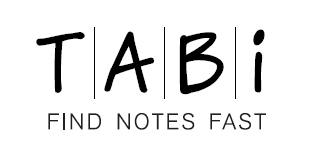
We all hate waste. Right? The planet is suffering from far too much waste and too few resources to replace our unquenchable desire for more. So how does this relate to notebooks?
The first point to make is that paper itself is often considered wasteful where digital alternatives abound. However, where notebooks like TABi are made from Forest Stewardship Council (FSC) approved sources, we are ensuring more trees get planted than are cut down. If there wasn’t a commercial reason to grow trees for paper, new trees wouldn’t be economical to plant. So a healthy sustainable market for paper products is perhaps not as bad as some of the pollution caused by the IT industry resulting from the manufacture of hardware as well as the electricity needed throughout their lives (including telecoms and online servers). The more quality paper we use, the more trees that get planted to mop up the CO2 our computers are responsible for.
But there is another point relating to how we use the paper in notebooks that might be considered as wasteful at first glance, and that’s where we decide to start a fresh page rather than try to fill up every square inch of empty space. By leaving empty space, especially the reverse of pages, we end up using more paper for the same volume of notes. The downside to filling up pages with randomly taken notes is that they then become a muddle of unrelated pieces of information where each item becomes harder and harder to find as the density of notes increases. It becomes extra hard to find notes written on the reverse of pages when you’re flicking through them. It also means that related thoughts can easily be pages away from each other (or even notebooks away!). A nightmare if you need one or more notes to help construct the one you’re working on.
TABi resolves this by letting you assign titles to every page, including its reverse, even if it is a continuation page for a previous title (some Tabists use coloured highlighters to link subjects). Instead of squeezing your next note into the first available space, you just find its subject on a previously dedicated tab, and then use the next available space on that page. Or you start another page with a continuation arrow on its tab if you need to. So you’re still squeezing notes into empty spaces, but now you’re also categorising them for fast retrieval later.
The biggest benefit of a TABi, or a digital notebook come to that, is the time and effort it saves in finding your notes again. But there is also a benefit in having your previous notes about that topic immediately to hand on the same page where you are crafting your current note. The one potentially wasteful downside is starting a fresh subject on a new page, but then not being able to fill the page with enough notes. This means it’s a jot, and we recommend you make jots on the set of pages with tabs at the bottom right corner of your TABi where they’re always quick and easy to find. At least you’ve then only got a small number of pages to search for a note you know is just a jot and didn’t warrant a whole page.

Leave a Reply